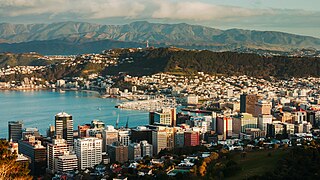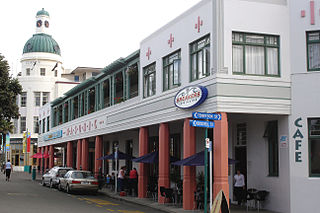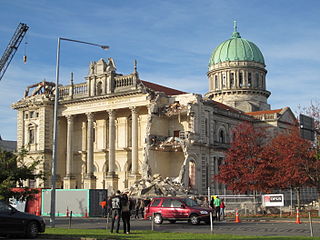
Wellington is the capital city of New Zealand. It is located at the south-western tip of the North Island, between Cook Strait and the Remutaka Range. Wellington is the third-largest city in New Zealand, and is the administrative centre of the Wellington Region. It is the world's southernmost capital of a sovereign state. Wellington features a temperate maritime climate, and is the world's windiest city by average wind speed.

Napier is a city on the eastern coast of the North Island of New Zealand and the seat of the Hawke's Bay region. It is a beachside city with a seaport, known for its sunny climate, esplanade lined with Norfolk pines, and extensive Art Deco architecture. Napier is sometimes referred to as the "Nice of the Pacific", although that is largely outdated and a more common nickname is 'The Art Deco Capital of the world'.

The 1931 Hawke's Bay earthquake, also known as the Napier earthquake, occurred in New Zealand at 10:47 am on 3 February, killing 256, injuring thousands and devastating the Hawke's Bay region. It remains New Zealand's deadliest natural disaster. Centred 15 km north of Napier, it lasted for two and a half minutes and had a magnitude of 7.8 . There were 525 aftershocks recorded in the following two weeks, with 597 being recorded by the end of February. The main shock could be felt in much of New Zealand, with reliable reports coming in from as far south as Timaru, on the east coast of the South Island.
Archives New Zealand is New Zealand's national archive and the official guardian of its public archives. As the government's recordkeeping authority, it administers the Public Records Act 2005 and promotes good information management throughout government.

Territorial authorities are the second tier of local government in New Zealand, below regional councils. There are 67 territorial authorities: 13 city councils, 53 district councils and the Chatham Islands Council. District councils serve a combination of rural and urban communities, while city councils administer the larger urban areas. Five territorial authorities also perform the functions of a regional council and thus are unitary authorities. The Chatham Islands Council is a sui generis territorial authority that is similar to a unitary authority.

The National Provincial Championship, often simply called the NPC, is an annual round-robin rugby union competition in men's domestic New Zealand rugby. First played during the 2006 season, it is the second highest level of competition in New Zealand alongside the Ranfurly Shield. It is organised by New Zealand Rugby (NZR) and since 2021, it has been known as the Bunnings NPC after its headline sponsor. A concurrent women's tournament is also held, the Farah Palmer Cup.
This is a timeline of environmental history of New Zealand. It includes notable events affecting the natural environment of New Zealand as a result of human activity.

The racing of Thoroughbred horses is a popular gaming and spectator sport and industry in New Zealand.

The Canterbury Rugby Football Union is the governing body for rugby union in a portion of the Canterbury region of New Zealand. Its colours are red and black in a hooped design. The CRFU govern the running of the Canterbury representative team which have won New Zealand's first-tier domestic competition National Provincial Championship 14 times including a "six-peat" from 2008 to 2013 – with five in the National Provincial Championship, two in the Air New Zealand Cup, five in the ITM Cup and one in the Mitre 10 Cup. Their most recent victory was the 2017 Mitre 10 Cup. Canterbury also acts as a primary feeder to the Crusaders, who play in the Super Rugby competition.

The High Court of New Zealand is the superior court of New Zealand. It has general jurisdiction and responsibility, under the Senior Courts Act 2016, as well as the High Court Rules 2016, for the administration of justice throughout New Zealand. There are 18 High Court locations throughout New Zealand, plus one stand-alone registry.
The following lists events that happened during 1964 in New Zealand.

New Zealand Red Cross or Rīpeka Whero Aotearoa is a humanitarian organisation, which has more than 9,000 members and volunteers. In New Zealand, Red Cross delivers core community services, such as Meals on Wheels, refugee re-settlement services, first aid courses, and emergency management operations. Internationally, New Zealand Red Cross sends international delegates overseas to assist in areas where humanitarian assistance is needed, this includes disaster preparedness and response. In 2013, 17 delegates were sent to the Philippines in the aftermath of Typhoon Haiyan and in 2014, 18 New Zealand delegates responded to the Ebola epidemic in West Africa.
The National Emergency Management Agency is the public service department of New Zealand responsible for providing leadership and support around national, local and regional emergencies. It is an autonomous departmental agency hosted by the Department of Prime Minister and Cabinet. It replaced the Ministry of Civil Defence and Emergency Management in December 2019.
The following lists events that happened during 2011 in New Zealand.
The 2010 Canterbury earthquake struck the South Island of New Zealand with a moment magnitude of 7.1 at on 4 September, and had a maximum perceived intensity of X (Extreme) on the Mercalli intensity scale. Some damaging aftershocks followed the main event, the strongest of which was a magnitude 6.3 shock known as the Christchurch earthquake that occurred nearly six months later on 22 February 2011. Because this aftershock was centred very close to Christchurch, it was much more destructive and resulted in the deaths of 185 people.

A major earthquake occurred in Christchurch on Tuesday 22 February 2011 at 12:51 p.m. local time. The 6.2 earthquake struck the Canterbury region in the South Island, centred 6.7 kilometres (4.2 mi) south-east of the central business district. It caused widespread damage across Christchurch, killing 185 people in New Zealand's fifth-deadliest disaster.
The following lists events that happened during 2017 in New Zealand.
The 2018–19 New Zealand Football Championship season was the fifteenth season of the NZFC since its establishment in 2004. Ten teams competed in the competition with Auckland City and Team Wellington representing the ISPS Handa Premiership in the 2019 OFC Champions League after finishing Champions and Premiers and runner-up respectively in the 2017–18 competition.
John Lysaght Moore was a New Zealand painter, printmaker, weaver and knitter. His work is in the collections of the National Library of New Zealand, the Museum of New Zealand Te Papa Tongarewa and the Auckland Art Gallery.










